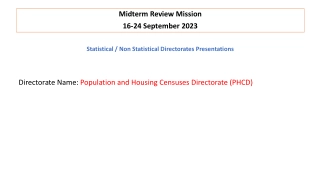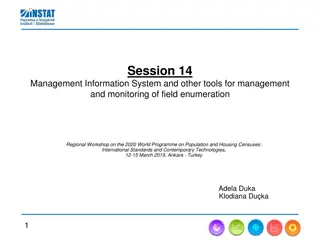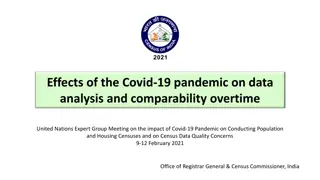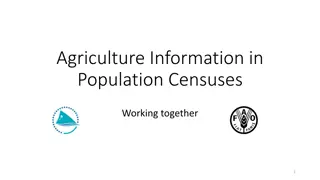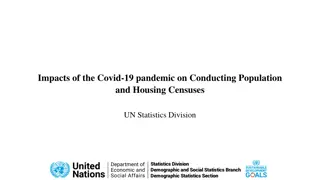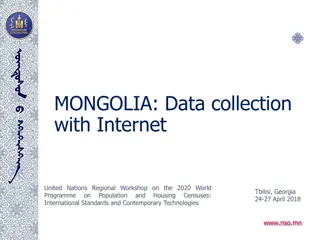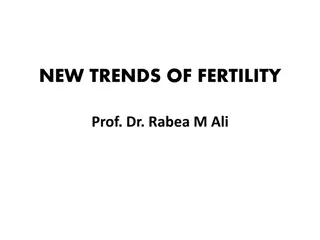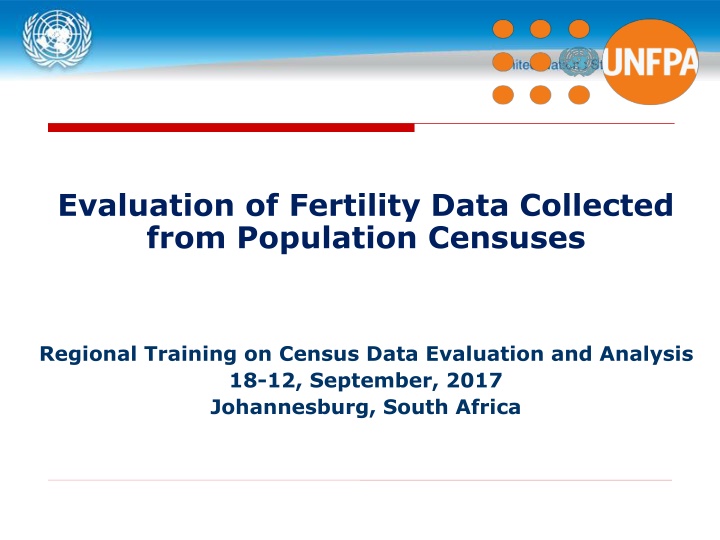
Evaluation of Fertility Data from Population Censuses and Analysis
This content discusses fertility measures, such as Crude Birth Rate and Total Fertility Rate, and their evaluation process. It covers data collection errors, methods for deriving fertility estimates, and comparing estimates from different sources.
Download Presentation

Please find below an Image/Link to download the presentation.
The content on the website is provided AS IS for your information and personal use only. It may not be sold, licensed, or shared on other websites without obtaining consent from the author. If you encounter any issues during the download, it is possible that the publisher has removed the file from their server.
You are allowed to download the files provided on this website for personal or commercial use, subject to the condition that they are used lawfully. All files are the property of their respective owners.
The content on the website is provided AS IS for your information and personal use only. It may not be sold, licensed, or shared on other websites without obtaining consent from the author.
E N D
Presentation Transcript
Evaluation of Fertility Data Collected from Population Censuses Regional Training on Census Data Evaluation and Analysis 18-12, September, 2017 Johannesburg, South Africa
Outline 1. Fertility measures (some definitions) 2. Evaluation of fertility data 1. Data collection errors, coverage, completeness 2. Methods for deriving fertility estimates 3. Comparing estimates from multiple independent sources United Nations Regional Workshop on Evaluation and Analysis of Census Data Johannesburg,18 22 September 2017
Fertility measures (some definitions) 1. Crude Birth Rate (CBR) 2. Child/Woman Ratio (CWR) 3. General Fertility Rate (GFR) 4. Age-Specific Fertility Rates (ASFR) 5. Total Fertility Rate (TFR) 6. Children ever born (CEB) United Nations Regional Workshop on Evaluation and Analysis of Census Data Johannesburg,18 22 September 2017
Crude Birth Rate (CBR) A simple ratio of the number of births in a particular period (usually a year) divided by the total population size ???? ? ?? ?????? ?????? ???? ?????????? ???? ? ?? ?????? ??? = CBR is commonly expressed in 1,000 population Denominator needs to be an average population size for the period concerned and this is often estimated as a mid-year population (average of the population at the start of the period and at the end of the period). >Denominator includes children, men, older persons that are not at risk of childbearing United Nations Regional Workshop on Evaluation and Analysis of Census Data Johannesburg,18 22 September 2017
Crude Birth Rate (CBR) Advantages CBR is a useful measure to approximate numbers of births when limited information available. For example, if population = 20 million, CBR = 13 per thousand, births next year 260,000 Disadvantages Denominator is the total population of all ages, but childbearing is concentrated among women aged 15-49 >> The proportional size of this group can vary considerably between populations, making comparison difficult CBR is confounded by age structure >>CBR is not used as an accurate measure of fertility >> Need a fertility measure that is standardized for population structure and therefore would give a more precise measure of fertility United Nations Regional Workshop on Evaluation and Analysis of Census Data Johannesburg,18 22 September 2017
Child/Woman Ratio (CWR) ?????? ? ?????? ???? 0 4 ????? ???? 15 49 ??? = CWR is a simple, but also not accurate measure of fertility; more a measure of population structure Useful as easy to calculate in simple small area surveys >> quick assessment of the burden of support that young children place on families in a community Problem Children who have died are not included in the numerator >> In high mortality settings, fertility will be underestimated Normally, CWR < 1 in low fertility countries, well below 1; in high fertility countries just under 1. United Nations Regional Workshop on Evaluation and Analysis of Census Data Johannesburg,18 22 September 2017
General Fertility Rate (GFR) ???? ? ?? ? ?????? ?????? ??? = ???? ?????? ?? ????? ???? 15 49 ?? ? ? ???? ?????? GFR gives total number of births for all women in the fertile ages Problem GFR also affected by age structure >> substantial differences in age structure between populations. Because fertility is concentrated at certain ages, populations can appear to have different levels of fertility simply because they have different age structures between ages 15-49 years. Problematic for international or time comparisons >> Age-Specific Fertility Rates (ASFR) and Total Fertility Rate (TFR) United Nations Regional Workshop on Evaluation and Analysis of Census Data Johannesburg,18 22 September 2017
Age-Specific Fertility Rates (ASFR) The age-specific fertility rate measures the annual number of births to women of a specified age or age group per 1,000 women in that age group ???? ? ?? ????? ???? ?,? + ? ?? ? ?????? ?????? ?????? ?? ????? ???? ?,? + ? ?? ? ? ???? ?????? ?????,?+?=???= Where x, x+n refers to age, usually 5-year age groups, which cover the age range 15-49. ASFR informs on the age patterns of fertility or fertility schedules United Nations Regional Workshop on Evaluation and Analysis of Census Data Johannesburg,18 22 September 2017
Age-Specific Fertility Rates (ASFR) Age pattern is important in demography If we know the pattern (i.e. the shape) of the phenomenon and recognize the distinct ways in which it changes under certain circumstances, but also recognize the stable features, then we can: a) check if data appears to be of good quality; b) attempt to correct irregularities that we suspect are due to poor data; c) make some predictions d) Is best for targeted programming and messaging of information United Nations Regional Workshop on Evaluation and Analysis of Census Data Johannesburg,18 22 September 2017
Age-Specific Fertility Rates (ASFR), 1995-2000 350 300 250 ASFR (p. 1000) 200 150 100 50 0 15-19 20-24 25-29 30-34 Age group 35-39 40-44 45-49 Niger Afghanistan Myanmar United Kingdom Somalia Haiti Poland Italy Source: UNPD (2013) United Nations Regional Workshop on Evaluation and Analysis of Census Data Johannesburg,18 22 September 2017
Age-Specific Fertility Rates (ASFR) Sweden 0.25 1891 1901 1911 1921 1931 1941 1951 1961 1971 1981 1991 2001 2011 0.2 0.15 ASFR 0.1 0.05 0 27 28 48 13 14 15 16 17 18 19 20 21 22 23 24 25 26 29 30 31 32 33 Age 34 35 36 37 38 39 40 41 42 43 44 45 46 47 49 50 51 52 53 54 -12 55+ Source: Human Fertility Database United Nations Regional Workshop on Evaluation and Analysis of Census Data Johannesburg,18 22 September 2017
Total Fertility Rate (TFR) TFR is independent of the effect of the age structure. TFR gives the number of births that women give birth to. TFR is the standard way to compare fertility levels across countries and time. 45 49 ??? = ???? 5 ?=15 19 Interpretation The number of children a woman would have if she lived from age 15 to age 49 and experienced the ASFRs of the period in question throughout her reproductive life. > It is an example of a synthetic cohort United Nations Regional Workshop on Evaluation and Analysis of Census Data Johannesburg,18 22 September 2017
Period Fertility vs. Cohort Fertility United Nations Regional Workshop on Evaluation and Analysis of Census Data Johannesburg,18 22 September 2017
Period Fertility vs. Cohort Fertility United Nations Regional Workshop on Evaluation and Analysis of Census Data Johannesburg,18 22 September 2017
Period Fertility vs. Cohort Fertility United Nations Regional Workshop on Evaluation and Analysis of Census Data Johannesburg,18 22 September 2017
Fertility measures (some definitions) 1. Crude Birth Rate (CBR) 2. Child/Woman Ratio (CWR) 3. General Fertility Rate (GFR) 4. Age-Specific Fertility Rates (ASFR) 5. Total Fertility Rate (TFR) Period Fertility 6. Children ever born (CEB) United Nations Regional Workshop on Evaluation and Analysis of Census Data Johannesburg,18 22 September 2017
Children ever born (CEB) and Cohort Fertility (CF) Measure of all live births a woman has had in her lifetime Asked to all women age 15 and older (sometimes age 12) CEB also called Summary Birth Histories (SBH) CEB of women age 45 and older (sometimes 40 and older) >> Estimates of cohort fertility (CF) (as these women have completed their reproductive life) United Nations Regional Workshop on Evaluation and Analysis of Census Data Johannesburg,18 22 September 2017
Outline 1. Fertility measures (some definitions) 2. Evaluation of fertility data 1. Data collection errors, coverage, completeness 2. Methods for deriving fertility estimates 3. Comparing estimates from multiple independent sources United Nations Regional Workshop on Evaluation and Analysis of Census Data Johannesburg,18 22 September 2017
1. Recent births o Measure of recent fertility o Asked to all women age 15 49 at the time of the census who reported at least one live birth in their lifetime o Preferred question: Date of birth of last child born alive (day, month and year) o Alternative question: Births in the last twelve months to the woman or in the household More error-prone than exact date of birth, although both are subject to under-reporting Date of birth can be converted to births in last 12 months during data processing (will miss only small percentage of cases in which woman had multiple births in a year) United Nations Regional Workshop on Evaluation and Analysis of Census Data Johannesburg,18 22 September 2017
2. Children ever born (summary birth histories) o Measure of all live births a woman has had in her lifetime o Asked to all women age 15 and older o For every woman the following information is collected: >Total number of female children she has borne in her lifetime >Total number of male children she has borne in her lifetime >Number of female children who are surviving >Number of male children who are surviving CEB/CS United Nations Regional Workshop on Evaluation and Analysis of Census Data Johannesburg,18 22 September 2017
2. Children ever born Recommended question sequence to improve completeness of data: 1. Total number of sons ever born alive during the lifetime of the woman 2. Total number of sons living (surviving) at the time of the census 3. Total number of sons born alive who died before the census data 4. Total number of daughters ever born alive during the lifetime of the woman 5. Total number of daughters living (surviving) at the time of the census 6. Total number of daughters born alive who died before the census date Source:United Nations (2015), Principles and Recommendations for Population and Housing Censuses United Nations Regional Workshop on Evaluation and Analysis of Census Data Johannesburg,18 22 September 2017
2. Children ever born When is it used? Widely used for over 50 years both for measures of fertility and for child mortality (next session) Very important for countries without or with incomplete birth registration Also important for countries with complete birth registration > Allows for the study of fertility by detailed socio-economic characteristics o o o United Nations Regional Workshop on Evaluation and Analysis of Census Data Johannesburg,18 22 September 2017
Fertility data possible errors Both methods: enumerator s error 1. Enumerators failure to reach individuals a) The not-at-home error: information provided by neighbors b) Coverage error: omit an area or forgot to record the answer 2. Recording error a) Answer is recorded incorrectly by the enumerator e.g., childless women misclassified into parity not stated United Nations Regional Workshop on Evaluation and Analysis of Census Data Johannesburg,18 22 September 2017
Recent births possible errors 1. Reference period errors a) Uncertain of the exact date of birth relative to the reference period b) Incorrectly moving birth into or out of the reference period 2. Births missed because mother not located a) Women had a birth recently but died or migrated before the census b) Household had a birth recently but the household dissolved before the census c) Not significant in most cases, however could become an issue when many deaths occurring in a short period (HIV/AIDS) or when there is significant migration United Nations Regional Workshop on Evaluation and Analysis of Census Data Johannesburg,18 22 September 2017
Children ever born possible errors 1. Errors because the respondent did not understand the question a) Mortality error: reported only children living rather than ever-born b) Non-resident error: did not report surviving children living elsewhere c) Marriage error: women not reporting her children born from previous marriage or children born out of wedlock 2. Errors because of respondents lapse of memory or neglect a) Memory error: respondent forgot some children >Believed to be more common among older women 3. Age misreporting a) Teenage mothers may exaggerate their age b) Age misreporting if this results in a systematic over- or under-stating of age United Nations Regional Workshop on Evaluation and Analysis of Census Data Johannesburg,18 22 September 2017
Methods for Deriving Fertility Estimates United Nations Regional Workshop on Evaluation and Analysis of Census Data Johannesburg,18 22 September 2017
CEB quality assessment (Step 1) Initial assessment of data quality and missing values Any missing values in CEB data? Missing value for any relevant variables? (age of mother, sex of child, survival status of the child) Was imputation, hotdecking or any other method used to clean the data? If so, should have a good understanding of the rules followed Note: hot-deck imputation > a missing value imputed from a randomly selected similar record United Nations Regional Workshop on Evaluation and Analysis of Census Data Johannesburg,18 22 September 2017
CEB quality assessment Source: Moultrie & Dorrington (2004), Estimation of fertility from the 2001 South Africa census data United Nations Regional Workshop on Evaluation and Analysis of Census Data Johannesburg,18 22 September 2017
CEB quality assessment (Step 2) Tabulation of children ever born Number of children should not be grouped, except for the last open category (usually no lower than 9+ or 10+ children) Children ever born not stated should be distinguished from no children (parity 0 ) Are parities reasonable? Quick rule-of-thumb: maximum parity should be one child every 18 months from age of 12 E.g. by exact age 20 (end of 15 19 age group) maximum children should be 5 Source: Moultrie et al. (2013) available online at: http://demographicestimation.iussp.org/ United Nations Regional Workshop on Evaluation and Analysis of Census Data Johannesburg,18 22 September 2017
CEB quality assessment Mongolia, 1989 Census (Source: IPUMS) Parity 0 1 2 3 4 5 6 7 8 9 10 11 12 13 14 15+ Unknown 15-19 105,548 4,827 20-24 43,676 30,834 17,309 5,382 1,828 25-29 30-34 35-39 40-44 45-49 9,824 15,350 23,960 19,279 11,831 5,730 2,161 707 263 119 2,711 5,432 10,659 11,159 11,922 11,189 7,568 3,737 2,355 746 419 147 987 865 726 2,185 4,479 4,923 6,974 7,426 6,348 4,551 3,879 2,190 1,300 743 262 161 1,302 2,217 2,663 3,525 4,933 4,442 3,638 3,986 2,747 2,433 1,183 845 403 242 235 1,488 2,053 1,950 2,658 3,379 3,619 2,977 3,706 3,059 3,253 1,667 1,299 898 392 629 896 834 199 68 477 53 25 23 Parities obviously wrong 0 0 15 61 0 0 22 0 0 0 218 9 0 0 0 0 38 0 0 0 0 11 0 0 0 65 53 19 20 0 58 82 72 35 Unknown separated from parity 0 35 20 United Nations Regional Workshop on Evaluation and Analysis of Census Data Johannesburg,18 22 September 2017
CEB quality assessment Mongolia, 1989 Census (Source: IPUMS) Parity 15-19 105,548 4,827 20-24 43,676 30,834 17,309 5,382 1,828 25-29 30-34 35-39 40-44 45-49 9,824 15,350 23,960 19,279 11,831 5,730 2,161 707 263 119 2,711 5,432 10,659 11,159 11,922 11,189 7,568 3,737 2,355 746 419 147 987 865 726 0 1 2 3 4 5 6 7 8 9 10 11 12 13 14 15+ Unknown 2,185 4,479 4,923 6,974 7,426 6,348 4,551 3,879 2,190 1,300 743 262 161 1,302 2,217 2,663 3,525 4,933 4,442 3,638 3,986 2,747 2,433 1,183 845 403 242 235 1,488 2,053 1,950 2,658 3,379 3,619 2,977 3,706 3,059 3,253 1,667 1,299 898 392 629 896 834 199 68 477 53 25 23 0 0 0 0 0 0 0 0 0 0 9 0 0 0 0 0 0 0 0 11 0 0 0 65 53 19 20 82 72 35 Total children by age group = Parity * women at that parity 0 58 35 20 316 38 Proportion with unknown parity should stay constant Total women 112,688 99,654 89,300 68,194 46,597 35,694 33,773 Total children 10,257 92,053 218,303 267,951 240,263 220,854 231,755 Proportion childless should decrease with age Proportion unknown 0.0028 0.0004 0.0007 0.0009 0.0008 0.0010 0.0006 Proportion childless 0.9366 0.4383 0.1100 0.0398 0.0212 0.0242 0.0215 Average parity 0.0910 0.9237 2.4446 3.9292 5.1562 6.1874 6.8621 Average parity should United Nations Regional Workshop on Evaluation and Analysis of Census Data Johannesburg,18 22 September 2017 increase with age
CEB quality assessment 7 Average parity at age x: = = x W Mongolia - 1989 6 Cambodia 2008 jW , j x 5 B Vietnam 2009 j x P Average parity j x 4 W , j x 3 where = x B W, 2 number of births by age x 1 = number of women of age x at parity j j x 0 15-19 20-24 25-29 30-34 35-39 40-44 45-49 Age group United Nations Regional Workshop on Evaluation and Analysis of Census Data Johannesburg,18 22 September 2017
CEB quality assessment Mongolia, 1989 Census (Source: IPUMS) Parity 15-19 105,548 4,827 20-24 43,676 30,834 17,309 5,382 1,828 25-29 30-34 35-39 40-44 45-49 9,824 15,350 23,960 19,279 11,831 5,730 2,161 707 263 119 2,711 5,432 10,659 11,159 11,922 11,189 7,568 3,737 2,355 746 419 147 987 865 726 0 1 2 3 4 5 6 7 8 9 10 11 12 13 14 15+ Unknown 2,185 4,479 4,923 6,974 7,426 6,348 4,551 3,879 2,190 1,300 743 262 161 1,302 2,217 2,663 3,525 4,933 4,442 3,638 3,986 2,747 2,433 1,183 845 403 242 235 1,488 2,053 1,950 2,658 3,379 3,619 2,977 3,706 3,059 3,253 1,667 1,299 898 392 629 896 834 199 68 477 53 25 23 0 0 0 0 0 0 0 0 0 0 9 0 0 0 0 0 0 0 0 11 0 0 0 65 53 19 20 82 72 35 0 58 35 20 316 38 Total women 112,688 99,654 89,300 68,194 46,597 35,694 33,773 Total children 10,257 92,053 218,303 267,951 240,263 220,854 231,755 Proportion unknown 0.0028 0.0004 0.0007 0.0009 0.0008 0.0010 0.0006 Proportion childless 0.9366 0.4383 0.1100 0.0398 0.0212 0.0242 0.0215 Average parity 0.0910 0.9237 2.4446 3.9292 5.1562 6.1874 6.8621 United Nations Regional Workshop on Evaluation and Analysis of Census Data Johannesburg,18 22 September 2017
CEB quality assessment 7 Underreporting Underreporting at older ages? at older ages? 6 5 Average parity Misreporting? Rising fertility? 4 3 Indonesia, 1990 Census Mongolia, 1989 Census 2 1 0 15-19 20-24 30-34 35-39 40-44 45-49 50-54 55-59 60-64 15-19 20-24 25-29 30-34 35-39 40-44 45-49 50-54 55-59 60-64 65-69 65+ 25-29 United Nations Regional Workshop on Evaluation and Analysis of Census Data Johannesburg,18 22 September 2017
The el-Badry Correction to adjust reported data on children ever born A common problem with CEB data is that enumerators may incorrectly code women of zero parity as parity unknown or parity not stated The el-Badry method corrects for this If parity unknown is less than 2% of each age group >> safe to assume that data are consistent and no correction needed. Detailed examples in: - United Nations (1983, pp. 230-235). - Moultrie et al. (2013, pp. 35-41). United Nations Regional Workshop on Evaluation and Analysis of Census Data Johannesburg,18 22 September 2017
Estimating fertility from data collected in censuses To obtain new estimates of fertility To compare estimates from the current census with estimates available from other sources e.g. surveys
Methods for estimating fertility > Interpolation of average parities (Mortara, 1949) > Brass P/F method and its variations and extensions, e.g. Arriaga (1983), Relational Gompertz model > Methods based on population structure: Reverse Survival Method and Own Children Method > Methods based on data from two or several censuses: Arriaga (1983), synthetic relational Gompertz model, parity increments
Interpolation and backdating average parities Average parity at ages x, x+n by definition: + x n x = ( ) P F a da n x where F is cohort cumulative fertility function. By using interpolation one can compute age-specific fertility rates from average parities, P, assuming that fertility was more or less constant before the census For ages with completed fertility, e.g. age > 45, we can assume that P TFR, total fertility for a given cohort By plotting P TFR at years defined by the census date and mean age at childbearing, one can produce estimates of historical TFR trends (Feeney, 1991, see slide presented before) Software: FERTCB application in MORTPAK
The P/F ratio method: Rationale The P/F method aims to balance out the strengths and weaknesses of CEB and recent fertility data by comparing: Cumulative fertility equivalent derived from recent fertility data F (trusting the age patternof fertility but not level) Life-time average parities P (trusting the overall level but not the age distribution) The method is typically used to adjust estimates of current fertility level (computed from data on recent births or from incomplete civil registration) The method is also used to assess the quality of CEB data and, sometimes, the age reporting of the mother Works well if: fertility was constant before the census (improbable now); no severe problems with the data Source: United Nations (1983) United Nations Regional Workshop on Evaluation and Analysis of Census Data Johannesburg,18 22 September 2017
P/F Method: Data requirements 1. Total number of children ever born by 5-year age group of mother 2. Recent fertility by 5-year age group of mother, measured either by: a) Births in past year question on census b) Births registered in year of census from vital registration 3. Total number of women in each 5-year age group United Nations Regional Workshop on Evaluation and Analysis of Census Data Johannesburg,18 22 September 2017
P/F Method: Assumptions Misreporting of current fertility is constant across all age groups Increasing under-reporting of parity (children ever born) by age of women Constant fertility (most important for youngest age groups up to 35 or so) > Can be relaxed through a modification of the original P/F ratio method that uses two consecutive censuses or fertility rates derived from vital registration or another data source United Nations Regional Workshop on Evaluation and Analysis of Census Data Johannesburg,18 22 September 2017
P/F Method: Computational procedure Procedure described here follows Arriaga (1983) implemented in MortPak 0 1 2 3 4 5 6 p(i) f(i) p*(i) f*(i) P(i) F(i) P/F Age Group Average CEB as shown ASFRs as shown Adjustment factor for fertility rates, usually ages groups 20-24, 25-29 or 30-34 as the most reliable CEB ASFR transformed into age- specific rates adjusted for time of census Cumulated P(i) and F(i)
P/F method: Interpretation Typical look of P/F ratios: With perfect data, ratio should be the same for all age groups and close to 1 In practice, ok if ratios for 20-24, 25-29 and (less important) 30-34 are close o Typically, P/F ratio will decrease with women s age o Deviation from the above typical pattern: indicates either violations of the assumptions or different patterns of under- reporting United Nations Regional Workshop on Evaluation and Analysis of Census Data Johannesburg,18 22 September 2017
Example in MortPak: Timor-Leste 2004 Census In the present case the adjustment factors are declining over the age groups: Increasing fertility or increasing mis-reporting with women s age? p*(i) f*(i) F(i) P(i) United Nations Regional Workshop on Evaluation and Analysis of Census Data Johannesburg,18 22 September 2017
P/F Method: Interpretation o Example 1: a declining trend in the P/F ratios by age of women could indicate that a) fertility has been increasing or b) reported data on children ever born suffer from progressively increasing omissions of children as age of women increases o Example 2: large fluctuations in the P/F ratios may reflect either differential coverage by age or selective age misreporting by women o Example 3: a rising trend in the P/F ratios by age of women indicates that fertility could have been decreasing in the past United Nations Regional Workshop on Evaluation and Analysis of Census Data Johannesburg,18 22 September 2017
Variants on the P/F method P/F method for first births not affected by fertility decline through higher-parity control Two-census methods, deriving age schedule of fertility from the two censuses or an additional source (such as vital registration) Can be implemented in MortPak FERTPF by adding optional data for second census The Relational Gompertz model uses the same data as the P/F model, but Does not require an assumption of constant fertility Compares/replaces recent fertility data with model fertility schedules to check accuracy Relies on parity data for all age groups (not just younger ones) United Nations Regional Workshop on Evaluation and Analysis of Census Data Johannesburg,18 22 September 2017
Main references Moultrie T.A., R.E. Dorrington, A.G. Hill, K. Hill, I.M. Tim us & B. Zaba (eds). 2013. Tools for Demographic Estimation. Paris: International Union for the Scientific Study of Population. available online at: http://demographicestimation.iussp.org/ Available in PDF: http://demographicestimation.iussp.org/content/get-pdf-book-website United Nations (1983), Manual X: Indirect Techniques for Demographic Estimation, New York: United Nations, available online at: http://www.un.org/en/development/desa/population/publications/manual/ estimate/demographic-estimation.shtml United Nations Regional Workshop on Evaluation and Analysis of Census Data Johannesburg,18 22 September 2017
Softwares MORTPAK The United Nations software package for demographic measurement, available online: http://www.un.org/en/development/desa/population/publications/mortality/m ortpak.shtml Excel templates provided with each chapter of Moultrie et al. (2013), available online: http://demographicestimation.iussp.org/ Programs for Fertility Estimation, East-West Center available online: http://www.eastwestcenter.org/research/research-program- overview/population-and-health/demographic-software-available-from- the-east-west-center United Nations Regional Workshop on Evaluation and Analysis of Census Data Johannesburg,18 22 September 2017
Other references Arriaga, E.E. (1983), Estimating Fertility from Data on Children Ever Born by Age of Mother, International Research Document No. 11. US Bureau of the Census, Washington, DC Avery C., T. St. Clair, M. Levin & K. Hill (2013), "The 'Own Children' fertility estimation procedure: A reappraisal", Population Studies 67(2): 171-183. Cho, L.-J., R.D. Retherford, & M. K. Choe (1986), The Own-Children Method of Fertility Estimation, Honolulu, University of Hawaii Press. Feeney, G. (1991), Child survivorship estimation: Methods and data analysis , Asian and Pacific Population Forum 5(2-3): 51-55, 76-87. Hinde, A. (1998), Demographic Methods, London: Arnold. IUSSP & UNFPA (n.d.), Population Analysis for Policies and Programmes, Paris: International Union for the Scientific Study of Population, available online (last accessed 25/11/2014): http://papp.iussp.org/ Moultrie, T.A. (2013), "The relational Gompertz model"., in T.A. Moultrie R.E. Dorrington, A.G. Hill, K. Hill, I.M. Tim us & B. Zaba (eds). Tools for Demographic Estimation. Paris: International Union for the Scientific Study of Population. Available online (last accessed 14/10/2014) http://demographicestimation.iussp.org/content/relational-gompertz-model Moultrie T. & R. Dorrington (2004), Estimation of Fertility from the 2001 South Africa Census Data, Centre for Actuarial Research, University of Cape Town. Spoorenberg, T. (2014), Reverse survival method of fertility estimation: An evaluation ,Demographic Research 31(9): 217-246. Tim us, I.M. & T.A. Moultrie (2013), "Estimation of fertility by reverse survival , in T.A. Moultrie, R.E. Dorrington, A.G. Hill, K. Hill, I.M. Tim us & B. Zaba (eds). Tools for Demographic Estimation. Paris: International Union for the Scientific Study of Population. available online (last accessed 25/11/2014): http://demographicestimation.iussp.org/content/reverse-survival-methods United Nations Regional Workshop on Evaluation and Analysis of Census Data Johannesburg,18 22 September 2017

